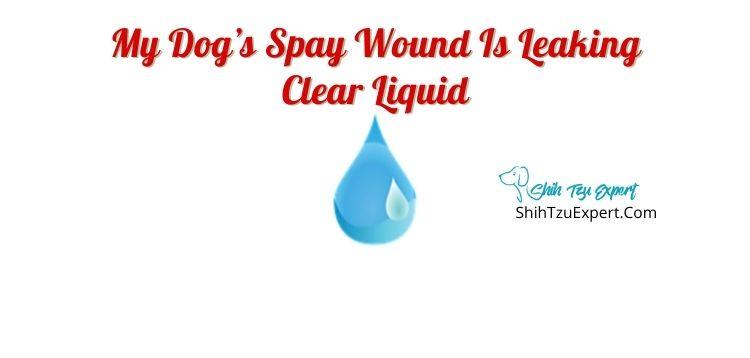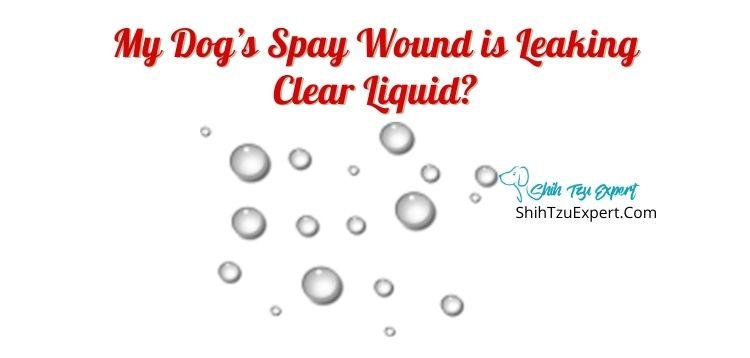1 in 10 dogs experience this issue. Spay wound leakage is caused by swelling under the skin after the surgery. In most cases, this is not dangerous and may not require treatment from a veterinarian. However, it is important to know whether your dog needs medical intervention.

Is It Safe For A Dog To Lick The Leaking Clear Liquid From The Spay Wound?
The liquid leaking from the wound is called serous liquid. This liquid exists inside tissues and is the ‘clear’ or fluid part of blood. While your dog cannot get sick from licking the fluid, licking the wound could irritate it.
So, yes, it is safe. However, you should monitor your dog. If the area seems to get alarmingly red, stop your dog from licking the wound.
Can You Treat A Leaking Spay Incision At Home?
In most cases, treatment is not required. The issue should resolve itself within two weeks. If the leaking does not stop, or if a build-up of the fluid seems to be staying under the skin, you would likely benefit from bringing your dog to the vet.
How To Treat A Leaking Spay Incision At Home?
The best at-home treatment is to limit your dog’s activity. Make sure they don’t put stress on their wound by running or playing too rough. If you notice your dog is licking the area excessively, you may consider putting a cone on them to prevent them from licking.
You may also apply a hot compress to your dog’s wound. This can provide relief to any discomfort your dog is experiencing but also reduces healing time.
Why Is My Dog’s Spay Incision Leaking Fluid?
Your dog’s wound could leak for two reasons:
- Your dog was too active after surgery.
- Your veterinarian left a pocket of space between tissues during surgery.
Having this issue post-surgery is not uncommon. In most cases, the fluid stays under the skin and forms a bump. However, if the fluid is leaking it should not be concerning unless it seems to be leaking excessively. You can always ask your vet about your pet’s situation.
What’s The Clear Liquid That Comes Out Of A Spay Incision Wound?

The liquid leaking from the wound is called serous liquid. This liquid lubricates your dog’s muscles, and it forms the fluid part of their blood. (And human too!) It is normal for some of this fluid to leak out your dog’s wound since it is inside of their muscles, you may even see a bit of blood.
However, if you start to notice that the wound is bleeding often and in large amounts, it would be smart to contact your veterinarian as soon as possible.
Is It Normal For A Spay Incision To Leak?
Yes, it is normal. You shouldn’t have to worry about your dog if you see some leakage after their surgery. If you see a lot of bleeding, or if the fluid is staying under the skin for longer than two weeks, it would be wise to consult your veterinarian.
Keep your dog calm and their activity low. This reduces the risk of further irritation or complications to their wound.
Should I Clean My Dog’s Spay Incision?
While it is not necessary to constantly clean the area, you can wipe it gently with a damp rag to keep it clean. Your dog may also benefit from a hot compress applied to the wound once or twice a day. Doing so may comfort your dog and speed up the healing process.
How Do You Tell If A Dog’s Spay Incision Is Infected Or Healing?
Here are some signs of infection in a dog’s surgery incision:
- Red or inflamed
- Hot to the touch
- Fever
- Pus leaking out of the incision
- The incision smells bad
Keep in mind that your dog will be going through a healing period after their surgery.
It is normal to have some lethargy, or irritation around the area. However, if your dog exhibited more than one of the symptoms above, you should contact your veterinarian.
What Is A Seroma?
A seroma is a buildup of serous fluid under the skin. In most cases, the seroma is absorbed back into the body within 10-20 days. A seroma usually forms after surgery.
If your dog develops a seroma but has not recently had a surgery, you should take it to your veterinarian.
In most instances, a seroma is not a serious issue. If it lasts too long, however, your veterinarian will have to drain the fluid.
Do Seromas Always Leak?
Seromas do not always leak. The seroma could stay under the skin and form a bump around or near the incision wound. The bump usually absorbs back into the body, but if it does not absorb within 10-20 days, a veterinarian would have to drain or extract the fluid.
Leaking is not abnormal, though, and should not raise alarm.
How Common Are Seromas After Spay?
10% of dogs develop a seroma after spaying. That means 1 in 10 dogs are diagnosed with a seroma post-surgery. It is common to see this happen to your dog and is usually harmless.
How Do I Know My Dog Has A Seroma?
If there is a bump or swelling surrounding or near your dog’s incision, your dog probably has a seroma. It is also possible that there is a clear or slightly yellow fluid leaking from the wound. There could be some redness or irritation, but if it seems hot or if smelly pus is leaking from it, there could be an infection.
Do Seromas Heal On Its Own?
In most cases, seromas heal on their own. Whether there is simply a bump or leaking fluid, your pet will likely heal within two to four weeks. If the healing seems to take longer than that, you should contact your veterinarian. If they deem it necessary, they will drain the fluid themselves.
Can Male Dogs Get A Seroma?
Yes, a male dog can get a seroma. If the seroma results from a surgery, it will likely heal on its own. If it did not occur as a result of surgery, you should contact your vet since it may be caused by a more serious underlying condition, like a blood clot.
Can Female Dogs Get A Seroma?
A female dog can get a seroma. If the seroma occurs because of a surgery, it will likely heal on its own. If it did not result from an operation, you should contact your vet since it may be caused by a more serious underlying condition, like a blood clot.
Can Spayed Dogs Get A Seroma?
If your dog is already spayed but had a surgery for other reasons, it can develop a seroma near or on the incision. If your dog has not had a surgery, it can still develop a surgery but may be more serious. Contact your veterinarian if your dog has a seroma for unknown reasons.
Can I Treat My Dog At Home For A Seroma?
For the most part, treatment is not needed. However, some at-home remedies can help your pet feel less irritated and keep the seroma healing.
- Apply a hot compress 1-2 times a day
- Monitor their temperature
- Keep their activity lower than usual (no rough playing or running)
Should I Take My Dog To The Vet For A Seroma?
If your dog has a seroma from a surgery, it will likely heal naturally. However, if the seroma has not healed after three weeks, contacting your veterinarian is wise. If your pet has a seroma and has not had a surgery recently, you should take them to their vet soon. Seromas that develop for unknown reasons are usually more dangerous.
How Should I Prevent A Seroma?
When your furry friend returns from a surgery, keep them inside and make sure they don’t run or play roughly. This could put stress on the incision and cause a seroma. You may wrap the area with gauze to keep swelling down and reduce the risk of a seroma.
Sometimes, though, a seroma is the direct result of how the surgery was performed, so don’t feel bad if they still develop a seroma after trying to prevent it.
Can A Dog Survive A Seroma?
In most cases, a seroma is not a serious issue and will not harm your dog. However, every pet is different, so if you are concerned about your dog, take them to your veterinarian.
How Long Can A Dog Live With A Seroma?
Don’t worry about your fur baby! Most seromas heal within a month, although larger seromas can take longer. If your dog’s seroma is not healing or shows signs of infection, you should have your vet take a look.
How Does A Dog Get A Seroma?
Most seromas develop after surgery when a pocket is left between the skin and the muscle. That could happen for two reasons:
- The surgeon left a pocket between the skin and muscle, causing trauma.
- Your dog was too active directly after surgery and caused stress inside the incision.
Thankfully, it should heal on its own and is not usually serious.
How Long Do Dog Seromas Last?
Your dog could take anywhere from two to five weeks to heal, depending on various factors such as how large the seroma is. If your dog’s seroma takes longer than that to heal, you should visit your veterinarian and voice your concerns.
What Does A Seroma On A Dog Look Like?
A seroma is usually a swollen bump under the skin around or near the incision from surgery. It should not be colored, although it could have a reddish tinge from swelling. The seroma can leak a clear fluid and even a bit of blood without being dangerous.
Sources:
What Are the Treatments for Seroma Formation in Dogs? | Cuteness
Seromas in Dogs: What are They & How are They Treated? | World Dog Finder
Seroma in Dogs – Post-Surgical Treatment and Prevention (animalwised.com)


![10 Best Dog Crates for Separation Anxiety [High anxiety dog crates 2019 Reviews] 10 Best Dog Crates for Separation Anxiety [High anxiety dog crates 2019 Reviews]](https://shihtzuexpert.com/wp-content/uploads/2019/05/5-3.jpg)

